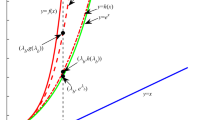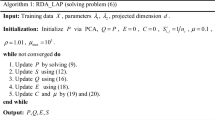Abstract
How to define the sparse affinity weight matrices is still an open problem in existing manifold learning algorithm. In this paper, we propose a novel supervised learning method called local sparse representation projections (LSRP) for linear dimensionality reduction. Differing from sparsity preserving projections (SPP) and the recent manifold learning methods such as locality preserving projections (LPP), LSRP introduces the local sparse representation information into the objective function. Although there are no labels used in the local sparse representation, it still can provide better measure coefficients and significant discriminant abilities. By combining the local interclass neighborhood relationships and sparse representation information, LSRP aims to preserve the local sparse reconstructive relationships of the data and simultaneously maximize the interclass separability. Comprehensive comparison and extensive experiments show that LSRP achieves higher recognition rates than principle component analysis, linear discriminant analysis and the state-of-the-art techniques such as LPP, SPP and maximum variance projections.



Similar content being viewed by others
References
Jain AK, Duin RPW, Mao J (2000) Statistical pattern recognition: a review. IEEE Trans Pattern Anal Mach Intell 22(1):4–37
Joliffe I (1986) Principal component analysis. Springer, New York
Fukunnaga K (1991) Introduction to statistical pattern recognition, 2nd edn. Academic Press, London
Martinez AM, Kak AC (2001) PCA versus LDA. IEEE Trans Pattern Anal Mach Intell 23(2):228–233
Belhumeour PN, Hespanha JP, Kriegman DJ (1997) Eigenfaces vs. fisherfaces: recognition using class specific linear projection. IEEE Trans Pattern Anal Mach Intell 19(7):711–720
Scholkopf B, Smola A, Muller KR (1998) Nonlinear component analysis as a Kernel eigenvalue problem. Neural Comput 10(5):1299–1319
Yang J, Frangi AF, Zhang D, Yang J-Y, Zhong J (2005) KPCA plus LDA: a complete Kernel fisher discriminant framework for feature extraction and recognition. IEEE Trans Pattern Anal Mach Intell 27(2):230–244
Tenenbaum JB, deSilva V, Langford JC (2000) A global geometric framework for nonlinear dimensionality reduction. Science 290:2319–2323
Roweis ST, Saul LK (2000) Nonlinear dimensionality reduction by locally linear embedding. Science 290:2323–2326
Zhang Z, Zha H (2004) Principal manifolds and nonlinear dimensionality reduction via tangent space alignment. SIAM J Sci Comput 26(1):313–338
Belkin M, Niyogi P (2001) Laplacian eigenmaps and spectral techniques for embedding and clustering. Proc Adv Neural Inf Process Syst Vancouver Can 14:585–591
Bengio Y, Paiement JF, Vincent P, Delalleau O, Roux N, Ouimet M (2003) Out-of-sample extensions for LLE, isomap, MDS, eigenmaps, and spectral clustering. Adv Neural Inf Process Syst 16:177–184
He X, Niyogi P (2003) Locality preserving projections. In: Proceedings of the seventeenth annual conference on neural information processing systems, Vancouver and Whistler, Canada
Chen H-T, Chang H-W, Liu T-L (2005) Local discriminant embedding and its variants. Proc IEEE Conf Comput Vis Pattern Recognit 2:846–853
Yan S, Xu D, Zhang B, Zhang H-J, Yang Q, Lin S (2007) Graph embedding and extensions: a general framework for dimensionality reduction. IEEE Trans Pattern Anal Mach Intell 29(1):40–51
Fu Y, Yan S, Huang TS (2008) Classification and feature extraction by simplexization. IEEE Trans Inf Forensics Secur 3(1):91–100
Zhang T, Yang J, Wang H, Du C (2007) Maximum variance projections for face recognition. Opt Eng 46(6):0672061–0672068
Fu Y, Yan S, Huang TS (2008) Correlation metric for generalized feature extraction. IEEE Trans Pattern Anal Mach Intell 30(12):2229–2235
Chung F (1997) Spectral graph theory, CBMS Regional Conference Series in Mathematics, no. 92
Wright J, Yang A, Sastry S, Ma Y (2009) Robust face recognition via sparse representation. IEEE Trans Pattern Anal Mach Intell 31(2):210–227
Huang K, Aviyente S (2006) Sparse representation for signal classification. Adv Neural Inf Process Syst 19:609–616
Lishan Q, Songcan C, Xiaoyang T (2010) Sparsity preserving projections with applications to face recognition. Pattern Recognit 43:331–341
He X, Cai D, Yan S, Zhang H (2005) Neighborhood preserving embedding. Proc Int Conf Comput Vis (ICCV) 2:1208–1213
Candes E., Romberg J (2005) l 1-magic: recovery of sparse signals via convex programming. http://www.acm.caltech.edu/l1magic/
Chen S, Donoho D, Sarnders M (2001) Atomic decomposition by Basis pursuit. SIAM Rev 43(1):129–159
Yang W, Sun C, Zhang L (2011) A multi-manifold discriminant analysis method for image feature extraction. Pattern Recognit 44(8):1649–1657
Zhao C, Liu C, Lai Z (2011) Multi-scale gist feature manifold for building recognition. Neurocomputing 74(17):2929–2940
Zhao H, Sun S, Jing Z, Yang J (2006) Local structure based supervised feature extraction. Pattern Recognit 39(8):1546–1550
Zhao H, Wong W (2012) Supervised optimal locality preserving projection. Pattern Recognit 45(1):1546–1550
Xu Y, Zhong A, Yang J, Zhang D (2010) LPP solution schemes for use with face recognition. Pattern Recognit 43(12):4165–4176
Lai Z, Wan M, Jin Z (2011) Locality preserving embedding for face and handwriting digital recognition. Neural Comput Appl 20(4):565–573
Acknowledgments
This work is partially supported by the Natural Science Foundation of China under grant No. 61203376, 61203243, 61005005, 61005008, 61105054, Hi-Tech Research and Development Program of China under grant No. 2006AA01Z119 and China Postdoctoral Science Foundation funded project 2012M511479.
Author information
Authors and Affiliations
Corresponding author
Rights and permissions
About this article
Cite this article
Lai, Z., Li, Y., Wan, M. et al. Local sparse representation projections for face recognition. Neural Comput & Applic 23, 2231–2239 (2013). https://doi.org/10.1007/s00521-012-1174-0
Received:
Accepted:
Published:
Issue Date:
DOI: https://doi.org/10.1007/s00521-012-1174-0




